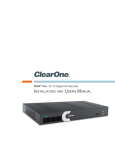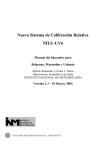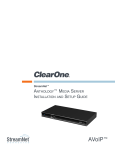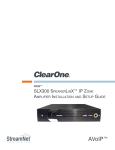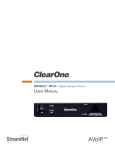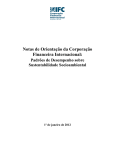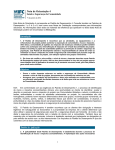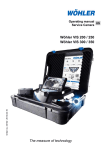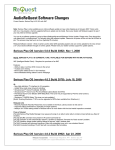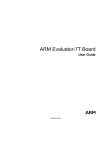Download ClearOne VIEW Pro - E120 User manual
Transcript
VIEW® Pro - E120 Digital AV Encoder Installation and User Manual AVoIP™ ClearOne 5225 Wiley Post Way Suite 500 Salt Lake City, UT 84116 Telephone 1.800.283.5936 1.801.974.3760 FAX 1.801.303.5711 E-mail On the Web [email protected] www.clearone.com VIEW Pro E120 Installation Manual ClearOne Document DOC-0149-001- October, 2014 (Rev. 1.0) © 2014 ClearOne All rights reserved. No part of this document may be reproduced in any form or by any means without written permission from ClearOne. ClearOne reserves specific privileges. Information in this document is subject to change without notice. Table of Contents INTRODUCTION Product Overview..................................................................................................................................................... 1 StreamNet AVoIP™ Video Platform....................................................................................................................................1 Device Application..............................................................................................................................................................1 Included with Your VIEW Pro Encoder................................................................................................................................1 CONNECTIONS Inputs and Connections.......................................................................................................................................... 2 Status LED..........................................................................................................................................................................2 10/100/1000 Ethernet Jack................................................................................................................................................2 HDMI Inputs........................................................................................................................................................................3 IR In....................................................................................................................................................................................3 IR Out .................................................................................................................................................................................3 RS-232 (COM)....................................................................................................................................................................3 19VDC Input.......................................................................................................................................................................3 INSTALLATION Physical Characteristics.......................................................................................................................................... 4 Dimensions (Excluding Connectors)..................................................................................................................................4 Mounting the E120................................................................................................................................................... 4 The E120 in a Network............................................................................................................................................. 6 Connecting the E120................................................................................................................................................ 6 SOFTWARE SETUP OF THE E120 LUA File.................................................................................................................................................................... 7 E120 Screens in the Dealers Setup Program......................................................................................................... 8 Adding an E120 to a Project..............................................................................................................................................8 The Information Tab..........................................................................................................................................................10 The Sources Tab...............................................................................................................................................................11 The Sources Tab Advanced Configuration......................................................................................................................12 Editing a Stream..........................................................................................................................................................13 Premium Features.......................................................................................................................................................15 Editing Stream Presets................................................................................................................................................15 Video Presets.......................................................................................................................................................16 Audio Presets.......................................................................................................................................................18 The GPIO Settings Tab.....................................................................................................................................................20 Input Macro Assignments...........................................................................................................................................20 Relay Assignments......................................................................................................................................................20 VIEW PRO RS-232 CONTROL LUA File Driver Templates..................................................................................................................................... 21 Preparing the New One-Way RS-232 Driver File.................................................................................................. 21 Preparing the Encoder/Decoder........................................................................................................................... 23 Modifying the One-Way Driver File....................................................................................................................... 24 VIEW PRO AND VIEW LEGACY INTEROPERABILITY Control Sharing...................................................................................................................................................... 29 Audio Streaming Interoperability.......................................................................................................................... 29 IR Learning and Control........................................................................................................................................ 30 Firmware Upgrading.............................................................................................................................................. 30 VIEW PRO ACCESSORY KITS Kit Descriptions...................................................................................................................................................... 31 COMPLIANCE Compliance Overview............................................................................................................................................ 32 RoHS Compliance............................................................................................................................................................32 Stainability........................................................................................................................................................................32 Electrical Safety Advisory...................................................................................................................................... 32 Compliance Details................................................................................................................................................ 32 FCC Compliance..............................................................................................................................................................32 European Compliance.....................................................................................................................................................32 SERVICE AND SUPPORT Technical Support.................................................................................................................................................. 33 Sales....................................................................................................................................................................... 33 Techsales................................................................................................................................................................ 33 Product Returns..................................................................................................................................................... 33 Introduction PRODUCT OVERVIEW StreamNet AVoIP™ Video Platform The StreamNet IP platform is designed to send high-quality audio and video over a TCP/IP network (AVoIP™). An encoder, such as a VIEW Pro E120, takes digital video and audio from a source device, such as a receiver, cable box or DVR, and makes the source available anywhere on the StreamNet network. A decoder, such as the VIEW Pro D110, takes the combined video and audio stream and decodes it. The D110 then sends the video and audio to a display such as a HDTV or projector and sound system. Device Application The E120 is a high definition, Internet Protocol, compressed multimedia encoder. The E120 connects to a TCP/IP network using an Ethernet connection. The E120, installed at the location of the multimedia source, works in connection with the D110 decoder, installed at the location of the display. Installation should be done by a qualified Dealer Service representative. Please consult the DigiLinX Installation Manual for device use in system configuration. Included with Your VIEW Pro Encoder The following items are included with the VIEW Pro Encoder: Item 910-0000-001 Description VIEW Pro Encoder E120 910-0002-001 Power Supply, Power Cord VIEW Pro Rack Mount • 2X - Rack Ear, Extended length QSG-0010-001 • 6X - Screw, M3 x 6mm, Pan-head, Philips, Thread Locking, Black VIEW PRO Encoder/Decoder Quick Start Guide Installation Manual 1 Connections The VIEW Pro E120 Encoder has the following input and output connectors on the back of the unit. • 1x - IR Input connector compatible with SteamNet IR sensor (3.5mm) • 1x - IR Input Receiver window on front panel • 1x - IR Output connector compatible with SteamNet IR emitter (3.5mm) • 2x - Balanced Audio Input (Two Modular Phoenix-type connectors, left and right) • 3x - GPIO (General Purpose Inputs - Digital, 0/5V, Phoenix-type) • 3x - GPIO (General Purpose Outputs - Latching, Relays, Phoenix-type) • 1x - Stereo 3.5mm Barrel Plug (Line Level) Input • 1x - Stereo 3.5mm Barrel Plug (Line Level) Output (Currently not used) • 2x - HDMI-input connectors. • 2X - RS-232 DB-9 connector • 2x - RJ45 10/100/1000 Mb Ethernet jack (Use only jack 1) • 3x - USB connectors (one USB connector on front panel not visible) • 1x - 19V DC Power Connector INPUTS AND CONNECTIONS The E120 transmits the digital video and audio on the network. Status LED An LED on the front panel lights up when the unit is powered and to report status: • Off=Off • Yellow=Update process has started (e.g.: Update Devices) • Blue=Normal Operation • Green=System Startup/shutdown • Red=Error Condition 10/100/1000 Ethernet Jacks The 10/100/1000 Mb Ethernet connector allows connection to TCP/IP networks setup to run StreamNet. Only Port 1 (Red Jack) is supported. The other is a service port that MUST NOT be connected. 2 Technical Support: 800.283.5936 HDMI Inputs The HDMI connectors on the E120 receive digital video and audio. IR In This jack allows connection of an StreamNet compatible infrared receiver. The infrared receiver can pick up IR remote control signals for IR learning. IR Out This jack allows connection of an infrared transmitter. The infrared transmitter can send IR remote control signals. RS-232 (COM) These jacks allow the E120 to control a source, or other connected source device. They support sending and receiving RS-232 commands to control devices. 19VDC Input This connector provides power input for the E120. This power is available using the included power supply. Installation Manual 3 Installation PHYSICAL CHARACTERISTICS Dimensions (Excluding Connectors) Width: 12.2 inches (310mm) Length: 7.4 inches (188mm) Height: 1.75 inch (44.4mm) MOUNTING THE E120 The VIEW Pro encoder includes a Rack Mount Kit (910-0002-001) with rack-mount ears that attach to the encoder to facilitate mounting in a standard rack. Surfacemounted, Mounting When the I/O connections are accessible from the back of the unit. (If needed, the unit can also mount with the I/O connections facing the front of the rack.) Rack Mounting Surface Mounting The VIEW Pro encoder can also be surface mounted using the optional Wall Mount Kit (910-0002002) with surface-mount ears that attach to the encoder to facilitate mounting. An optional VESA mount bracket Kit (910-0002-006) is available for applications where an encoder must be located on a VESA mount. Rack Mounting VESA Bracket 4 Technical Support: 800.283.5936 Wall Bracket (Mount to stud or other solid surface) Unit with VESA Bracket hangs on Wall Bracket There may some situations where the VIEW Pro cables cannot be concealed within a cabinet or in a wall. These cables can be surface mounted and concealed using the optional 910-0002-003 VIEW Pro Cable Raceway Kit. This raceway, in 12-inch joinable lengths, can be mounted to the wall to secure and cover the cables to the VIEW Pro devices. Use included wire ties to secure the cables to the wall bracket Mount the wall brackets to a solid surface. (Wall screws not included) Make 11 inch spacing between top and bottom bracket mounting holes The metal cover snaps onto the wall-mounted brackets Edge protectors prevent cover from making contact with the cables. Two sections or more kits may be combined to make a longer raceway. Join them using the included spring pins. The metal cover may be cut to size as needed. Installation Manual 5 THE E120 IN A NETWORK The VIEW Pro E120 encoder takes digital video and audio from source devices such as media/disc players, cable/satellite boxes, DVRs, and cameras, and then makes the digital video and audio available anywhere on the StreamNet® IP network. a StreamNet TCP/IP network using a standard 10/100/1000 Mbit Ethernet connection. The VIEW Pro decoders, as counterparts, are installed at the locations of the target video displays. They operate together: the encoders providing the IP data for the decoders to deliver to the displays.. CONNECTING THE E120 The E120 Encoder connections are from the back of the unit as shown in the following diagram. Left/Right Balanced Inputs 6 GPIO Ports for Control 3 Inputs and 3 Outputs COM2 Port for Source/3rd-Party Device Control 2 HDMI Audio/Video Port COM1 Port for Source/3rd-Party Device Control Power On/Off 3.5mm IR Input IR Learning 6 3.5mm IR 19 VDC 2 x USB Network Port2 Network Port1 3.5mm Audio 3.5mm Line-level (Currently Not Used) Output for Input from 3.0 Ports Output for Line-level Audio Input Source Display Power for USB Audio or Digital or 3rd-Party Adapter Audio/Video Audio Output (Currently Not Used) Control Devices Technical Support: 800.283.5936 DSP forced air intake Software Setup of the E120 The E120 is setup for use in a commercial or residential network using the StreamNet Dealer Setup program and the accompanying StreamNet Dealer Setup manual. StreamNet Dealer Setup is a PC-based program that allows you to configure devices so that they can communicate across a StreamNet network. Phases of the software setup include: • Adding or creating a new project or opening an existing project • Finding the new device • Matching the new E120 physical hardware device to the hardware setup in the project • Configuring the device with system-specific information • Saving the project • Sending the configuration files to the devices The steps involved in these processes are detailed in the DigiLinX Dealer Setup manual available for viewing or download at www.ClearOne.com. LUA FILE Control options for VIEW Pro devices using StreamNet Dealer Setup is facilitated but the .lua file found in the C:\Program Files x86)\ClearOne\StreamNet Application Suite\viewPro\drivers directory VIEW Pro has two DB9 Serial ports available on both Encoder and Decoder. Information about editing and using .lua files for RS-232 control is included in the VIEW Pro RS-232 Control section later in this manual. Installation Manual 7 E120 SCREENS IN THE DEALER SETUP PROGRAM Verify the configuration information on the tabs for the E120 device as shown in the following screen examples: Adding an E120 to a Project 8 Technical Support: 800.283.5936 1. Enter the following information: Device Name - Edit to name the E120 Device. Model Number - Select the E120 Device. 2. Enter the following information: GPIO Name - This is mainly used in macros By default this receives the Device Name. Source Names - Edit to name sources. (There are two HDMI Audio/Video and two AnalogOnly Audio (Balanced, UnBalanced) sources available for the E120.) »» NOTE: Whatever you type in for each source name here will appear in the list of sources on the TouchLinX touch panel interface and VIEW Virtual Matrix. Source Type - Use the drop-down list (using the down arrow key) to select what type of source this is for each named source. The source type brings up the appropriate controls for the source. There are several types of sources. »» NOTE: Source type parameters and definitions that are used in StreamNet networks are contained in .lua driver files. Customized types can be created using existing files as templates, editing them as desired, and saving as a new type that is then available for use by the VIEW Pro. For more information regarding creating an using template files, see the Using Templates section later in this document 3. Select Save & Continue 4. Complete the information for each E120 in your project. Installation Manual 9 The Information Tab The Information tab contains all of the information about that particular A/V device: Current IP Address - The current IP address of the E120. Current Subnet Mask - The current subnet mask of the E120. Device Type - The type of device that this is. Model Number - The E120 model number. Firmware Version - What firmware version is currently running on the E120. Device Name - Descriptive name assigned to the device when creating the project. Serial Number - Displays the E120 serial number. Device Comments - Indicate where the device is installed so that if you need to return to the installation for service or upgrading devices, you can have access to this information in the project file. 10 Technical Support: 800.283.5936 The Sources Tab The Sources tab contains all of the settings and information about the sources connected to the E120: There are two Audio/Video (HDMI) and two Analog sources available for the E120. Each one used needs to be configured within the project. Source Name - This name appears as a selection on all user interfaces and identifies the source. Source Type - The type of source connected to the VIEW Pro. (May be selected from CD player, DVD player, DVR, generic device, generic media server or cameras etc.) Driver File - The new driver file for the video source. (Allows you to select the designated .lua driver file. The ViewPro Lua files are stored in the ClearOne StreamNet Dealer Setup directory (C:\ Program Files (x86)\ClearOne\StreamNet Application Suite\viewPro\drivers). »» NOTE: A replacement .lua file can be created from a template that will allow customizing the VIEW Pro encoder/decoder to receive RS-232 commands instead of IR. For more information regarding creating an using template files, see the Using Templates section later in this document Audio Source - Allows you to select what kind of audio input the VIEW Pro uses for this stream. (May be selected from HDMI 1, HDMI 2, Balanced or Unbalanced.) Installation Manual 11 Gain - The Audio Gain drop-down for setting the audio input gain up or down to match that of other sources in the system. Select from ± 0, 3, or 6 dB amplification or attenuation of audio source. Advanced Configuration - This button is unavailable and greyed out when any <Video Stream> source Enable check box is selected. To enter Advanced Configuration, un-check the Enable check boxes, and press the Apply button. Now the Advanced Configuration button is available The Sources Tab Advanced Configuration If all the <Video Stream> Enable check boxes are unchecked, advanced configuration is available to specify the details of the source streams. Up to two Audio/Video streams can be defined as well as multiple Audio-Only streams. To open Advanced Configuration, click on the Advanced Configuration button on the bottom of the screen in the Sources tab. This screen allows the addition, editing and deletion of device streams for the encoder. When a new stream is added, it can be selected to then edit the stream and edit the stream presets. 12 Technical Support: 800.283.5936 EDITING A STREAM Click on the name of the stream you are editing, then click on Edit Stream. On the Edit Stream screen you can select from preset characteristics for the stream. Installation Manual 13 Audio Device – The physical input port for the audio stream. Video Device – The physical input port for the video stream. Audio Preset File – The audio preset file that is linked to this stream. Video Preset File – The video preset file that is linked to this stream Driver File – The lua driver that executes any source or 3rd-party commands coming from the network to control the stream including IR. »» NOTE: A replacement .lua file can be created from a template that will allow customizing the VIEW Pro encoder/decoder to receive RS-232 commands instead of IR. For more information regarding creating an using template files, see the VIEW Pro RS-232 Control section later in this document. Source Type – The type of source for the stream (CD, DVD, Tuner). Gain - Sets the volume of the stream in the final mix. The Audio Gain drop-down for setting the audio input gain up or down to match that of other sources in the system. Select from ± 0, 3, or 6 dB amplification or attenuation of audio. Slave Service Names – The names of the lua/ir services in the system that handle ASCII control commands. Height – The display height of the stream in pixels. Width – The display width of the stream in pixels. Channels Count - Sets the number of audio channels that are present in the stream. Max Allowed Latency - Sets the maximum latency the video stream allows, beyond which frames will be dropped to avoid limit-less buffering. Audio Only – makes the stream audio only, with no video present. Framerate Slave - When turned on, the stream’s frame rate is dynamically controlled by the source layout’s frame rate. Otherwise, the frame rate is set by these parameters. Resolution Slave - When turned on, the stream’s resolution is dynamically controlled by the source layout’s resolution. Otherwise, the resolution is set by these parameters. Enable RTSP Stream - Decides whether the data will be available through a UNICAST RTSP stream as well as the default proprietary stream. Unicast RTSP Streaming means that every instance of the Stream selected by an RTSP Player (e.g.: PotPlayer, VLC) will create a unique RTSP Stream from the Encoder. Three programs trying to access this stream over RTSP will require the Encoder to create three instances of the stream, which takes up resources within the Encoder and limits the number of Players that can watch/listen to this stream. 14 Technical Support: 800.283.5936 PREMIUM FEATURES Legacy Audio Support - This Premium Licensed Feature allows the creation of Audio-Only Streams which can be selected and listened to using the ClearOne Legacy Renderers (SLxxx, VLxxx). MultiCast RTSP Support - This Premium Licensed Feature allows an RTSP-compatible A/V or audio-only stream to be created within the Encoder. When creating an Multicast RTSP stream, the Basic Features box for Enable RTSP Stream must also be checked. Multicast RTSP Streaming means that the Encoder will create only one instance of the A/V or Audio Only Stream, and will send it to Players requesting a connection via Multicast. Any number of Players can attach to this Stream without increasing bandwidth or processing loading on the Encoder. Multicast RTSP requires Licensing, but any number of Players can join the Stream without additional overhead CPU or Networking capacity being used due to the use of the Multicast Networking. EDITING STREAM PRESETS User Video and Audio Presets can be created, deleted or edited for use in any stream configuration to meet the requirements of the sources and encoder. Once a preset has been created it can be assigned and enabled to any device stream. »» NOTE: Dealer Setup comes with several pre-defined preset settings for video and audio. These pre-defined presets can be used, but cannot be deleted nor edited; only user-created presets can be changed or removed. Click on the Edit Presets button to open the Preset Editor screen. The Preset Editor screen has panels listing video and audio presets. Selecting a preset from either of the panels presents the selected preset characteristics in the right hand panel. Adding or Deleting of presets is done with the Add and Delete buttons. Click on the Edit Presets button to open the Preset Editor screen. The Preset Editor screen has panels listing video and audio presets. Selecting a preset from either of the panels presents the selected preset characteristics in the right hand panel. Adding or deleting of presets is done with the Add and Delete buttons. Installation Manual 15 Video Presets The following screen shows the “HD Video Distribution” in the Preset Editor with details on the right hand panel. 16 Technical Support: 800.283.5936 Video Presets Descriptions HD Video Distribution - Video Distribution containing high-definition content for large screen high quality applications. PC Presentation - Utilizes 4:4:4 Video at 24-bit color depth for maximum clarity. RTSP Lan Mode - Optimized for Distributing RTSP video streams for LAN applications. RTSP Wan Mode - Optimized for Distributing RTSP video streams for WAN applications. Signage Active Content - Digital Signage containing embedded videos and/or rapid movement. Signage - Digital Signage content containing mostly static images and text Video Distribution - Distribution for high-definition content at a lower bandwidth for basic video applications. Setting Video Preset Values Video Bitrate – Sets the desired video bitrate of the video (in Mbps). Frame Rate – The output frame rate. Allow Bandwidth Spikes – If checked, allows the stream to exceed the allotted bandwidth momentarily, but not on average. Useful for LANs, reduces latency. Use 444 Mode – Sets color sampling to 24 bits. The pre-existing presets are set with these default values. Video Presets Signage Active Content Signage HD Video Distribution Video Distribution PC Presentation RTSP LAN Mode RTSP WAN Mode Video Bitrate (Mb/s) 60Mb 16Mb 60Mb 16Mb 60Mb 8Mb 2Mb Frame Rate 60 60 60 60 60 60 60 Allow Bandwidth Spikes Yes Yes Yes Yes Yes No No Use 444 Mode No No No No Yes No No Installation Manual 17 Audio Presets The following screen shows the “PCM High Bitrate” in the Preset Editor with details on the right hand panel. 18 Technical Support: 800.283.5936 Audio Presets Descriptions PCM High Bitrate - Configured for High Definition Movie and Video Distribution applications. PCM Low Bitrate - Configured for Basic Digital Signage and Video Distribution applications. RTSP Audio - Configured using AAC Audio required by most RTSP applications. Setting Audio Preset Values Audio Bitrate - Sets the bitrate in bps of the audio encoding. Select 32000. 96000, 128000, 192000 or 320000 bps. Audio Codec - Sets the codec used for audio. acAAC means using AAC encoding, acPCM will use PCM 16-bit uncompressed audio. Sample Rate - Sets the sampling rate of the stream’s audio. Select 32000, 44100, 48000, 96000, 128000 or 192000 bps. The pre-existing presets are set with these default values. Audio Presets PCM High Bitrate PCM Low Bitrate RTSP Audio Audio Bitrate 192000 128000 128000 Audio Codec acPCM acPCM acAAC Sample Rate (kHz) 48000 44100 44100 Installation Manual 19 GPIO Settings Tab This tab allows you to choose a macro associated with each input state: High/Open and Low/ Closed. The VIEW Pro macros are created and used in the same manner as the VIEW legacy products. Refer to the Dealer Setup Manual, Chapter 11 Section 1 (11-1) for the “Favorites section,” which explains macros in detail. The GPIO Tab contains six GPIO components (3x Input Triggers and 3x Relays). INPUT MACRO ASSIGNMENTS: In the GPIO Tab you can select previously created Macros from the drop-down list for both or one Input states High/Open and Low/Closed, these Macros are triggered based on the configured state and State changes. RELAY ASSIGNMENTS: Each of the three relays can be set in three states: None, Normally Open and Normally Closed. These relays can be triggered to change state between Normally Open and Normally Closed to trigger an event with the connected devices (projector lifts, motorized screens, lighting, shades, etc...). These relays can be triggered by system macros (found in Macro Builder) or via TCP/IP and/ or serial control commands. 20 Technical Support: 800.283.5936 VIEW Pro RS-232 Control The VIEW Pro has two DB9 Serial ports available on both Encoder and Decoder. The function and operation of the ports is defined in a .lua file used as a driver and implemented through StreamNet Dealer Setup. These ports communicate RS-232 commands and can be used in the following scenarios: 1. Input and/or Output Control. 2. Source Control. 3. Display Control The VIEW Pro .lua files are stored in the ClearOne StreamNet Dealer Setup directory : (C:\Program Files (x86)\ClearOne\StreamNet Application Suite\viewPro\drivers). If both Serial ports are to be used, then the Serial Comm Port number will need to be specified in each .lua File with a “1” or a “2” (port = “comm://default;baud=9600;bits=8;parity=0;stop=1”). LUA FILE DRIVER TEMPLATES Driver templates created from .lua files allow the installer to create drivers that can send RS-232 commands to a source. These commands are one-way only. They are NOT capable of receiving messages from the source. This is the same level of control as using IR, but with a RS-232 connection. One-way driver templates are configured by modifying a supplied .lua file. These instructions will guide you through this process and assume you are a trained StreamNet Installer and have a working knowledge of Windows. What you need: • E120 • D110, D210 • DB9 Serial cable • RS-232 controlled source • DB9 Gender-bender (depends on source) • Null Modem Cable or Adapter (depends on source) PREPARING THE NEW ONE-WAY RS-232 DRIVER FILE Driver templates can be found in <StreamNet Application Suite>\ViewPro>\Drivers. You will need to copy and rename the appropriate driver template into <StreamNet Application Suite>\ ViewPro>\Drivers. If the Drivers folder does not already exist go ahead and create the folder and copy the .lua file into it. Then rename the file. This will allow you to select the driver in Dealer Setup and leave you a backup copy of the original template. Installation Manual 21 For Example: If you are creating a one way RS-232 file for a DVD you would: • Locate the Driver Template directory (i.e. C:\Program Files (x86)\ClearOne\StreamNet Application Suite\viewPro\drivers) • Copy the DVDTEMPLATE.LUA file into the Drivers folder that you created • Rename the DVDTEMPLATE.LUA 22 In this example, we will call it TESTDVD.LUA Technical Support: 800.283.5936 PREPARING THE ENCODER/DECODER The next step is to configure the Encoder/Decoder device. Add the Encoder/Decoder as you normally would. Do NOT choose a source type that is tied to a specific manufacturer or product model. If you are in doubt choose the source type you would use if this were and IR device. For this example, we would choose DVD. Installation Manual 23 Once the device is added select the Sources tab for the Encoder/Decoder. Change the Driver file from IR to your newly created driver. For this example, we would change the driver file from IR to DVDTemplate.lua. Now Apply your changes. The Encoder/Decoder is now configured to use your one-way Driver file. So far all you have applied is a renamed file. Now you need to modify the driver file to support your source. MODIFYING THE ONE-WAY DRIVER FILE To modify a Driver Template you will need to use a text editor like Notepad. Notepad is included in Windows XP and Vista. Next you’ll need the RS-232 Protocol for the source. This is normally found on the manufacturer’s website. This document will tell you the communication settings, pin connections, and the RS-232 commands. 24 Technical Support: 800.283.5936 In the RS-232 Protocol section of the .lua file, locate the communication settings. Normally these settings will include: Baud rate, Data Bit, Stop Bit, and Parity. Once you find them you will need to verify that these commands match those used in the driver file. To do this, open the file in your text editor: Do a text search for: baud= You are looking for this line: port = “comm://default;baud=9600;bits=8;parity=0;stop=1”, Installation Manual 25 Verify that the baud, bits, parity, and stop values in the driver file match the settings listed in the RS232 Protocol. Most devices use Baud=9600, Data bits=8, Parity=0, and Stop bits=1. Now locate the Command table in the driver file. Do a text search for: local CmdTable = 26 Technical Support: 800.283.5936 Below the local CmdTable = text are the available commands where you can enter RS-232 commands. For each command you will enter the command between the quotation marks. For example: To enter the RS-232 command for TUNE UP: Locate the TUNE UP command line: [‘TUNE UP’] = “”, Add the appropriate RS-232 command for the source to do a TUNE UP between the quotes [‘TUNE UP’] = “W 1 6 1”, Note that in most RS-232 Protocols you are required to put a Carriage Return to indicate an end of command. Use %0D to indicate a Carriage Return. [‘TUNE UP’] = “W 1 6 1%0D”, Installation Manual 27 Your table should begin looking like this: Once you have completed your changes, save the file. From Dealer Setup, send the configuration to your Encoder/Decoder. The StreamNet GUI will now send the RS-232 command to the source via the DB9 port instead of the IR. 28 Technical Support: 800.283.5936 VIEW Pro and VIEW Legacy Interoperability There are several types of interoperability with VIEW Pro and the legacy VIEW products: • Control Sharing • Audio Streaming Interoperability • IR Learning and Control • Firmware Upgrading CONTROL SHARING From a command and control standpoint, VIEW legacy and VIEW Pro devices all appear and act the same; that is, a TouchLinX Touch Panel, Virtual Control, and VIEW Virtual Matrix (VVM) can all be used to control both types of products. Currently, command and control, and audio streams are seamless between the products. For instance, a TouchLinX can control source selection for VIEW Pro and StreamNet devices. In StreamNet, Static Menus are menus that appear for selection in a particular room. Static Menus can be created using VIEW Pro sources in the same manner as the legacy VIEW products. Refer to Chapter 17 of the Dealer Setup Manual for “Using Static Menus.” This explains Static Menus in detail. The VIEW Virtual Matrix software (VVM) is a program interface that can be run on a PC or laptop running Microsoft Windows 7. Unlike the room-centric based StreamNet virtual control software GUI that is created by a dealer with the StreamNet Dealer Setup software, VVM Is a system-centric control software GUI. This makes it much easier for you to control large systems, or control many rooms on a single screen. In VVM the sources and destinations are differentiated by color for VIEW legacy and VIEW Pro. • Light Blue Color = VIEW Legacy Devices • Light Green Color = VIEW Pro Devices AUDIO STREAMING INTEROPERABILITY A VIEW Pro Decoder can receive audio sourced from VIEW MLA100/101/9101/4000, MLAV300/9300/9500, audio ports enabled for global selection, also iPOD Dock, and VL100/9100/9300 reverse audio. Conversely, StreamNet Devices can play audio streams from a VIEW Pro Encoder. At this time, video cannot be shared across the Products because they are using different compression schemes. »» NOTE: Bridging Audio between VIEW Pro and StreamNet is a Licensed Feature. See your ClearOne business contact for additional information. Installation Manual 29 IR LEARNING AND CONTROL The accessory kits for the IR Emitter and IR Receiver allow the use of these devices with the VIEW Pro products. For example, an IR Emitter can be placed over the integrated IR Receiver of a display so signals from the VIEW Pro can be used to control the display. An IR Receiver unit can be used to receive and relay IR commands to a device placed out of the line of sight of the IR control device. The VIEW Pro IR tools and IR learning are used in the same manner as the VIEW Legacy products. Refer to Chapter 7 for the IR Tools section, first section (7-2) explains IR Learning in detail. 3.5mm IR Input IR Learning 3.5mm IR Output for Source Display or 3rd-Party Control Transmit direction IR Emitter (Self adhesive) Sensor direction IR Receiver (Self adhesive) FIRMWARE UPGRADING VIEW Pro The devices can update their firmware in the same manner as the VIEW Legacy devices. Refer to the Dealer Setup Manual, Chapter 3, Section 2 (3-2) for “Creating and Saving Projects,” which explains the Firmware Update process in detail. 30 Technical Support: 800.283.5936 VIEW Pro Accessory Kits KIT DESCRIPTIONS The following accessory kits are available to meet the mounting and control needs of your VIEW Pro Encoders and Decoders: Part Number 910-0002-001 910-0002-002 910-0002-003 Kit Name VIEW Pro Rack Mount Description Rack Mount Kit for VIEW Pro Encoder E120, Decoder D110 (Included with Encoder) • 6X - Screw, M3 x 6mm, Pan-head, Philips, Thread Locking, Black Wall Mount Kit for VIEW Pro Encoder E120, Decoder D110 VIEW Pro Wall Mount • 2X - Rack Ear, Extended length • Bracket 1Ru Rack/Wall Mount (Included with Decoder) • 2X - Screw, M3 x 6mm, Pan-head, Phillips, Thread Locking, Black VIEW Pro Cable Raceway • 2X - Bracket, 19V PSU Wall mount Cable Raceway Kit (12 inch) for Wall Mount Kit for VIEW Pro Decoder D110 (Optional) • 1X - Extrusion, Cable Raceway Cover, 12 inch • 2X - Bracket, Cable Raceway Wall-mount Clip • 2X - Cable Tie (4 inch) • 2X - Spring Pin, 5-64 inch x 1 inch 910-0002-004 910-0002-005 VIEW Pro IR Receiver (Optional) VIEW Pro IR Receiver & Emitter (Optional) 910-0002-006 • 2X - Plastic, Edge Protector, 3 inch IR Receiver cable for VIEW Pro Encoder E120, Decoder D110 • 1X - IR Receiver Assembly with 6 ft. cable IR Receiver Cable, IR Emitter Cable Kit for VIEW Pro Encoder E120, Decoder D110 • 1X - IR Receiver with 6 ft. cable, 3.5 mm plug VIEW Pro VESA bracket • 1X - IR Emitter with 6 ft. cable, 3.5 mm plug Wall Mount VESA Bracket Kit for VIEW Pro Encoder E120, Decoder D110 (Optional) • 1X - Bracket, VESA and Hanging Mount • 1X - Bracket, Wall Side Mount • 2X - Bracket, 19V PSU Wall mount • 4X - Screw, M4 X 6mm, Pan-Head, Phillips, Plain Installation Manual 31 Compliance COMPLIANCE OVERVIEW RoHS Compliance All components and processes used to produce the E120 will comply with the RoHS initiative. Sustainability The E120 is compliant with the WEEE recycling initiative. It is made from easily recyclable materials such as aluminum and steel. ELECTRICAL SAFETY ADVISORY This equipment uses DC power supplied from an external source which can be subjected to electrical surges, typically lightning transients which are very destructive to customer terminal equipment. The warranty for this equipment does not cover damage caused by electrical surge or lightning transients. To reduce the risk of this equipment becoming damaged it is suggested that the customer consider installing a surge arrestor. Any modifications to the device without express authorization from ClearOne is prohibited as per 47CFR15.21 and could void the users authority to operate the device. COMPLIANCE DETAILS FCC Compliance FCC Part 15: This device complies with FCC Part 15 regulations for a Class A device. »» NOTE: This Class A device complies with Part 15 of the FCC rules and Canadian ICES-003. Operation is subject to the following two conditions: (1) this device may not cause harmful interference, and (2) this device must accept any interference received, including interference that may cause undesired operation. European Compliance Details on European equipment compliance can be found on the ClearOne website. 32 Technical Support: 800.283.5936 Service and Support If you need assistance setting up or operating your product, please contact us. We welcome your comments so we can continue to improve our products and better meet your needs. Technical Support Telephone:1.800.283.5936 E-mail: [email protected] Web site: www.ClearOne.com Sales Telephone:1.800.707.6994 E-mail: Techsales [email protected] Telephone:1.800.705.2103 E-mail: [email protected] Product Returns All product returns require a Return Material Authorization (RMA) number. Contact ClearOne Technical Support before returning your product. Make sure you return all the items and packing materials that originally shipped with your product. AVOIP™ HEADQUARTERS: Salt Lake City, UT USA 5225 Wiley Post Way Suite 500 Salt Lake City, UT 84116 EMEA Tel: +44.1454.616.977 e-mail: [email protected] APAC Tel: +011.852.3590.4526 e-mail: [email protected] LATAM Tel: 801.974.3621 e-mail: [email protected] TechSales Tel: 800.705.2103 e-mail: [email protected] Technical Support Tel: 800.283.5936 e-mail: [email protected] Tel: 801.975.7200 Toll Free: 800.945.7730 Fax: 801.303.5711 e-mail: [email protected] Installation Manual 33





































